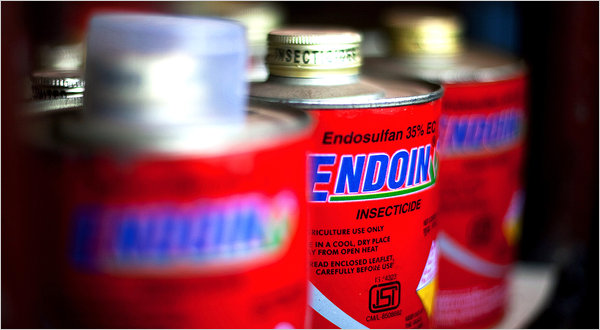Review on Endosulfan:
The pace of life is getting faster..! As we move faster in life, we have no time to even think over on matters that would affects us or even our children or the coming generations, though we hear voices for going green, environment protection, climate change and etc but are we really serious on these issues?
Recently there had been widespread news and coverage on the extensive usage and health hazards caused by pesticide called Endosulfan, Lets get to the never of the issues and understand the mayhem of Endosulfan, which is a categorized as a persistent organic pollutant (POP) as defined under the Stockholm convention. It is persistent in the environment, bio-accumulative, demonstrates long range environmental transport, causes adverse effects to human health and environment. Endosulfan is listed as persistent organic pollutant in the convention on Long range Transboundary Air Pollution and is recognized as a Persistent Toxic Substance by the United Nations Environment Programme.
History of Usage:
First registered for use in 1954, endosulfan is a broad-spectrum organo-chlorine insecticide. Following international recognition of their long-term negative impacts on the global environment, organochlorines including Hexachlorocyclohexane (HCH), dichlorodiphenyltrichloroethane (DDT), and chlordane have been largely eliminated from use in global agriculture. Endosulfan remains the major exception and is still extensively applied to crops in India especially used extensively in plantation of Kerala, Tamil Nadu, Karnataka, Assam and other states.
Devastating Consequence:
Widespread contamination is the greatest threat caused by these organochlorines especially its potential to evaporate and travel long distances in the atmosphere, endosulfan has become one of world’s most widespread pollutants. Endosulfan is now found extensively in global water resources, soils, air, rainfall, snow, ice deposits and oceans including in remote ecosystems such as the Arctic, Antarctic, Great Lakes, Canadian Rockies, Costa Rican rainforests, Alps and Himalayas.
Threats to Humans:
Studies suggest that endosulfan is a widespread contaminant found in the human food chain human breast milk and has been found in samples from women in Egypt, Madagascar, South Africa, El Salvador, Kazakhstan, India, Indonesia, Pakistan, Spain, Colombia, Nicaragua, Sub-Saharan Africa, Denmark, Finland and in umbilical cord blood samples in Denmark, Finland, Spain, USA and Japan. A survey of women in Denmark and Finland found endosulfan in all samples of breast milk and in all placental samples. Ironically neither country has ever recorded heavy use of endosulfan.
Threats to wildlife:
According to the European Union “endosulfan is very toxic to nearly all kinds of organisms. The levels in the environment are currently high enough to adversely impact the wildlife. In a another study by US Environment Protection Agency reports confirm that endosulfan is moving through aquatic, terrestrial food chains and that its use has resulted in adverse effects on the environment adjacent to and distant from its registered usage sites in other parts of the world. Endosulfan is detected in the tissues of animals worldwide, including polar bears, antelope, crocodiles, Minke whales and African vultures.
Unsafe to users:
According to the US EPA, endosulfan presents short and intermediate term risks for personnel working with these insecticides and pesticides especially mixers, loaders and applicators for the majority of uses, even with maximum personal protective equipment and engineering controls.
Mandatory safety equipment in the US includes chemical resistant footwear, chemical resistant gloves, chemical resistant headgear and a respirator. A survey of endosulfan sprayers working in Spain, all had traces of the insecticide in their blood.
Widespread Poisonings:
Endosulfan is one of the most frequently reported causes of unintentional poisoning, particularly in Asia, Latin America and West Africa. Most cases occur as a result of occupational exposure. Poisoning incidents, including fatalities, are documented in Benin, Colombia, Costa Rica, Guatemala, India, Indonesia, Malaysia, Philippines, Mali, New Zealand, Senegal, South Africa, Sri Lanka, Togo, Turkey and USA.
Impacts on Health:
Acute endosulfan poisoning can cause convulsions, psychiatric disturbances, epilepsy, paralysis, brain oedema, impaired memory and death. Long-term exposure is linked to immunosuppression, neurological disorders, congenital birth defects, chromosomal abnormalities, mental retardation, impaired learning and memory loss.
Possible Food Contamination:
Endosulfan is an abundant food contaminant globally and is present in a wide range of fruits, vegetables, dairy products and meat (beef, lamb, pork). In Africa, Asia and South America, endosulfan is present in drinking water resources, while in USA, China, Australia and West Africa, endosulfan has been detected in fish and seafood.
Conclusion:
Immediate measures are to be taken for a global ban on endosulfan and its nearest derivatives, already it has been banned or withdrawn in 55 countries worldwide. In February 2008, Benin became the first major West African country to announce a ban, following recommendations from local pest management experts.
Safer alternatives are to be pursued and according to experts successful replacement of endosulfan has been achieved in all countries where endosulfan is now banned including France, Spain, Greece and Portugal – all major users prior to the EU ban in 2006. Farmers in some non-EU countries have also converted away from endosulfan, including in cotton, soy and coffee production. A study in Sri Lanka showed that yields of all crops, including rice and tea, have been maintained since a national ban in 1998.
If we still ignore all early sings and warnings of the fore coming destruction, then its time for a wipe out of human race from this mighty planet.
For more updates visit HarNeedi.com OR Visit Facebook, Twitter and LinkedIn


